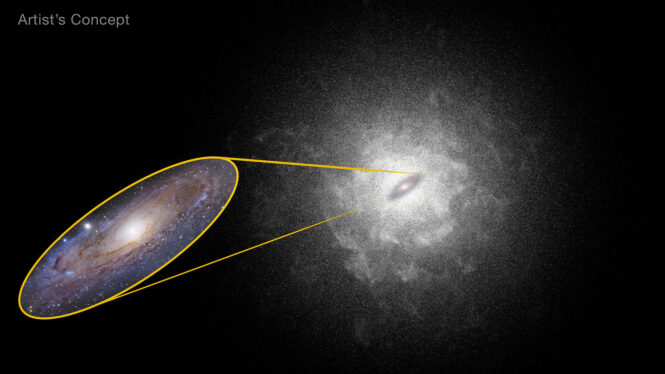
The universe is a dynamic, ever-changing place where galaxies are dancing, merging together, and shifting appearance. Unfortunately, because these changes take millions or billions of years, telescopes can only provide snapshots, squeezed into a human lifetime.
However, galaxies leave behind clues to their history and how they came to be. NASA’s upcoming Nancy Grace Roman Space Telescope will have the capacity to look for these fossils of galaxy formation with high-resolution imaging of galaxies in the nearby universe.
Astronomers, through a grant from NASA, are designing a set of possible observations called RINGS (the Roman Infrared Nearby Galaxies Survey) that would collect these remarkable images, and the team is producing publicly available tools that the astronomy community can use once Roman launches and starts taking data. The RINGS survey is a preliminary concept that may or may not be implemented during Roman’s science mission.
Roman is uniquely prepared for RINGS due to its resolution akin to NASA’s Hubble Space Telescope and its wide field of view – – 200 times that of Hubble in the infrared – – making it a sky survey telescope that complements Hubble’s narrow-field capabilities.
Galactic Archaeologists
Scientists can only look at brief instances in the lives of evolving galaxies that eventually lead to the fully formed galaxies around us today. As a result, galaxy formation can be difficult to track.
Luckily, galaxies leave behind hints of their evolution in their stellar structures, almost like how organisms on Earth can leave behind imprints in rock. These galactic “fossils” are groups of ancient stars that hold the history of the galaxy’s formation and evolution, including the chemistry of the galaxy when those stars formed.
These cosmic fossils are of particular interest to Robyn Sanderson, the deputy principal investigator of RINGS at the University of Pennsylvania in Philadelphia. She describes the process of analyzing stellar structures in galaxies as “like going through an excavation and trying to sort out bones and put them back together.”
Roman’s high resolution will allow scientists to pick out these galactic fossils, using structures ranging from long tidal tails on a galaxy’s outskirts to stellar streams within the galaxy. These large-scale structures, which Roman is uniquely capable of capturing, can give clues to a galaxy’s merger history. The goal, says Sanderson, is to “reassemble these fossils in order to look back in time and understand how these galaxies came to be.”
Shedding Light on Dark Matter
RINGS will also enable further investigations of one of the most mysterious substances in the universe: dark matter, an invisible form of matter that makes up most of a galaxy’s mass. A particularly useful class of objects for testing dark matter theories are ultra-faint dwarf galaxies. According to Raja GuhaThakurta of the University of California, Santa Cruz, “Ultra faint dwarf galaxies are so dark matter-dominated that they have very little normal matter for star formation. With so few stars being created, ultra-faint galaxies can essentially be seen as pure blobs of dark matter to study.”
Roman, thanks to its large field of view and high resolution, will observe these ultra-faint galaxies to help test multiple theories of dark matter. With these new data, the astronomical community will come closer to finding the truth about this unobservable dark matter that vastly outweighs visible matter: dark matter makes up about 80% of the universe’s matter while normal matter comprises the remaining 20%.
Ultra-faint galaxies are far from the only test of dark matter. Often, just looking in an average-sized galaxy’s backyard is enough. Structures in the halo of stars surrounding a galaxy often give hints to the amount of dark matter present. However, due to the sheer size of galactic halos (they are often 15-20 times as big as the galaxy itself), current telescopes are deeply inefficient at observing them.
At the moment, the only fully resolved galactic halos scientists have to go on are our own Milky Way and Andromeda, our neighbor galaxy. Ben Williams, the principal investigator of RINGS at the University of Washington in Seattle, describes how Roman’s power will amend this problem: “We only have reliable measurements of the Milky Way and Andromeda, because those are close enough that we can get measurements of a large number of stars distributed across their stellar halos. So, with Roman, all of a sudden we’ll have 100 or more of these fully resolved galaxies.”
When Roman launches by May 2027, it is expected to fundamentally alter how scientists understand galaxies. In the process, it will shed some light on our own home galaxy. The Milky Way is easy to study up close, but we do not have a large enough selfie stick to take a photo of our entire galaxy and its surrounding halo. RINGS shows what Roman is capable of should such a survey be approved. By studying the nearby universe, RINGS can examine galaxies similar in size and age to the Milky Way, and shed light on how we came to be here.
The Nancy Grace Roman Space Telescope is managed at NASA’s Goddard Space Flight Center in Greenbelt, Maryland, with participation by NASA’s Jet Propulsion Laboratory and Caltech/IPAC in Southern California, the Space Telescope Science Institute in Baltimore, and a science team comprising scientists from various research institutions. The primary industrial partners are BAE Systems, Inc in Boulder, Colorado; L3Harris Technologies in Rochester, New York; and Teledyne Scientific & Imaging in Thousand Oaks, California.
By Patt Molinari
Space Telescope Science Institute, Baltimore, Md.
Media contact:
Claire Andreoli
claire.andreoli@nasa.gov
NASA’s Goddard Space Flight Center, Greenbelt, Md.
301-286-1940
Ann Jenkins
Space Telescope Science Institute, Baltimore, Md.
Christine Pulliam
Space Telescope Science Institute, Baltimore, Md.




